英语语法之主谓一致
英语语法---主谓一致
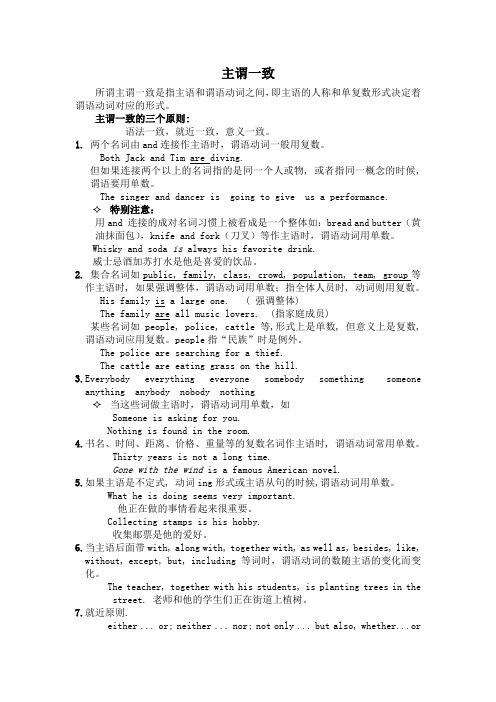
主谓一致所谓主谓一致是指主语和谓语动词之间,即主语的人称和单复数形式决定着谓语动词对应的形式。
主谓一致的三个原则:语法一致,就近一致,意义一致。
1.两个名词由and连接作主语时,谓语动词一般用复数。
Both Jack and Tim are diving.但如果连接两个以上的名词指的是同一个人或物, 或者指同一概念的时候, 谓语要用单数。
The singer and dancer is going to give us a performance.✧特别注意:用and 连接的成对名词习惯上被看成是一个整体如:bread and butter(黄油抹面包),knife and fork(刀叉)等作主语时,谓语动词用单数。
Whisky and soda is always his favorite drink.威士忌酒加苏打水是他是喜爱的饮品。
2.集合名词如public, family, class, crowd, population, team, group等作主语时, 如果强调整体,谓语动词用单数;指全体人员时, 动词则用复数。
His family is a large one. ( 强调整体)The family are all music lovers. (指家庭成员) 某些名词如people, police, cattle等,形式上是单数, 但意义上是复数, 谓语动词应用复数。
people指“民族”时是例外。
The police are searching for a thief.The cattle are eating grass on the hill.3.Everybody everything everyone somebody something someone anything anybody nobody nothing✧当这些词做主语时,谓语动词用单数,如Someone is asking for you.Nothing is found in the room.4.书名、时间、距离、价格、重量等的复数名词作主语时, 谓语动词常用单数。
(完整版)英语语法主谓一致

主一致1.主一致是指英中在人称、数及意方面要与作主的名或代一致。
2.主一致分法一致、意一致、就近一致。
(1)法一致原:主和在法形式上保持一致。
主数,用数;主复数,用复数。
I often help him and he often helps me.(2)意一致原:主和在意上复数一致。
主数,用数;主复数,用复数。
The police are searching the woods for the murderer.(3)就近素来原:当主有两个或两个以上,由凑近它的主确定。
并列主的一致1.And(1)两个数名用and 接,表示不同样看法,用复数。
Tom and Jack are close friends.(2)两个数名用 and 接,表示同一歌人、同一个物,同一个看法,或表示不可以切割的整体,用数。
The singer and dancer is to attend our evening party.(3)被 every, each, many a, no 等限制的数名由 and 接,仍用数,其中,后一个限制可以省略。
every ⋯⋯ and ⋯⋯ every,each⋯⋯ and⋯⋯ each,no⋯⋯ and⋯⋯ no, many a⋯⋯ and⋯⋯ manya。
Each boy and (each) girl has an apple.(4)一个数名被几个用 and 接的并列形容修,可以指一件事或几件事,种名作主,要依照意一致的原决定复数。
(5)由 and 接的两个what 的从句作主,要依照意一致的原决定复数What he says and does do not agree.(言不衷心致)What he says and does does not concern me.2.由 either or, neither nor, not but, not only but also,or, nor接的并列主,常和近的主一致。
【高中英语】高中英语语法之主谓一致

【高中英语】高中英语语法之主谓一致除了课堂上的学习外,平时的积累与练习也是学生提高成绩的重要途径,本文为大家提供了高中英语语法之主谓一致,祝大家阅读愉快。
(1)邻近原理①由并列结构或连词(either…or,neither…nor,not…but,notonly…butalso,or等)连接的并列主语,谓语动词与靠近的那个名词或代词保持一致。
他的父母中没有一个是汤姆。
汤姆和他的父母都不在家。
注:如果由“非此即彼、非此即彼、非此即彼或”连接的两个主语是一个复合词,最好将复数主语置于复数动词之后。
②在倒装句和therebe句型中,谓语动词与后面的第一个主语保持一致。
桌子上有一本书和几本书。
桌子上有一本书和几支钢笔。
③ 在定语从句中,关系代词是主语,其谓语动词应与其所指的先行词一致。
iknowthemanwhoistalkingtomyfather.我认识和我父亲说话的那个人。
④在强调句中,连接代词又在句中作主语,这时它应与被强调的主语保持一致。
这可能是在事故中受伤的其他人。
是玛丽的哥哥在车祸中受伤了。
(2)意义一致性原则①当主语与谓语动词之间插入alongwith,with,aswellas,togetherwith,nolessthan,besides,except,but,including等短语时,谓语动词不受这些插入语的干扰,依然和主语保持一致。
i、下个月我会和我的老师一起去上海。
我,还有我姐姐,打算下个月去上海。
② 在英语中,有一种单数和复数词(people、means、sheet、deer、fish等),其单数和复数取决于其在句子中的意义。
allofthepeopleinthecountryhavebeenpreparedforthegreatreformation.这个国家的人民已经准备好迎接巨大的变革。
③多数情况下,由“what”引导的名词性从句作主语时,其后的谓语动词通常用单数形式。
英语语法——主谓一致

主语复--谓语复 ; 主语单---பைடு நூலகம்-谓语单
A knife and fork_i_s_ used to have meals.
(and 后无冠词) 指同一个人
(and 后无冠词)
The singer and dancer__is__ on the stage.
指一副刀叉
主语复--谓语复 ; 主语单-----谓语单
主语形单意复,谓语用复数 主语形复意单,谓语用单数
谓语的单复数形式 取决于最靠近他的主语。
“主语+ 附属结构” 作主语 谓语与主语一致
语法一致
主语复--谓语复 ; 主语单-----谓语单
1.常见复数形式名词:
(1)Trousers、scissors(剪刀)、 clothes、goods(货物)、glasses、shoes
Every boy and every girl in the class _______(be) diligent. No sound and no voice _______(be) heard.
主语复--谓语复 ; 主语单-----谓语单
7. many a, more than one, one and a half与单数名词组成的短语 ——— 谓语动词用单数
主形单意复,谓语复;主形复意单,谓语单
2. 有些以-s 结尾的名词虽形式是复数, 但意义上是单数(形复意单)谓语用单
① Every means _h_a_s___ been tried since then. ② No news __i_s_ good news. (is / are) ③ Maths / physics __i_s__ the subject that I like most. (is / are)
初中英语语法之主谓一致
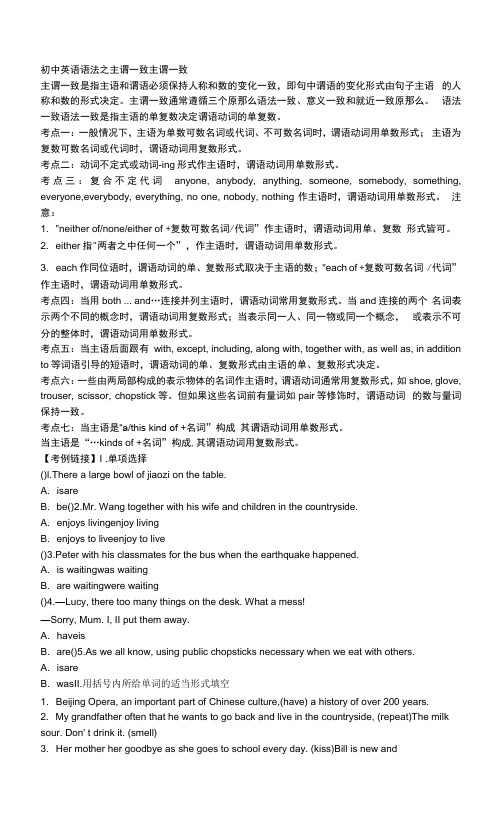
初中英语语法之主谓一致主谓一致主谓一致是指主语和谓语必须保持人称和数的变化一致,即句中谓语的变化形式由句子主语的人称和数的形式决定。
主谓一致通常遵循三个原那么语法一致、意义一致和就近一致原那么。
语法一致语法一致是指主语的单复数决定谓语动词的单复数。
考点一:一般情况下,主语为单数可数名词或代词、不可数名词时,谓语动词用单数形式;主语为复数可数名词或代词时,谓语动词用复数形式。
考点二:动词不定式或动词-ing形式作主语时,谓语动词用单数形式。
考点三:复合不定代词anyone, anybody, anything, someone, somebody, something, everyone,everybody, everything, no one, nobody, nothing 作主语时,谓语动词用单数形式。
注意:1. "neither of/none/either of +复数可数名词/代词”作主语时,谓语动词用单、复数形式皆可。
2. either指"两者之中任何一个”,作主语时,谓语动词用单数形式。
3. each作同位语时,谓语动词的单、复数形式取决于主语的数;"each of +复数可数名词/代词”作主语时,谓语动词用单数形式。
考点四:当用both ... and…连接并列主语时,谓语动词常用复数形式。
当and连接的两个名词表示两个不同的概念时,谓语动词用复数形式;当表示同一人、同一物或同一个概念,或表示不可分的整体时,谓语动词用单数形式。
考点五:当主语后面跟有with, except, including, along with, together with, as well as, in addition to等词语引导的短语时,谓语动词的单、复数形式由主语的单、复数形式决定。
考点六:一些由两局部构成的表示物体的名词作主语时,谓语动词通常用复数形式,如shoe, glove, trouser, scissor, chopstick等。
主谓一致的原则

主谓一致的原则主谓一致是英语语法中的基本原则之一,指的是主语和谓语在人称和数上要保持一致。
主谓一致的正确运用能够使句子表达更加准确,符合语言规范。
本文将详细介绍主谓一致的原则,并通过一些例子来加深理解。
一、基本原则在英语句子中,主语和谓语之间必须保持一致,具体包括以下几个方面:1. 人称一致:主语是第一人称(I、we)、第二人称(you)或第三人称(he、she、it、they)时,谓语动词的形式必须与之一致。
例如:- I am a student.(我是一名学生。
)- He sings beautifully.(他唱得很美。
)2. 数一致:主语是单数形式时,谓语动词的形式也要用单数;主语是复数形式时,谓语动词的形式也要用复数。
例如:- The dog barks loudly.(这只狗叫得很大声。
)- The birds are chirping.(鸟儿正在鸣叫。
)3. 特殊情况:有些特殊情况下,主谓一致的原则会有一些变化。
例如:- 不定代词:somebody, anybody, nobody, everybody等当作主语时,谓语动词形式使用第三人称单数形式。
例如:Nobody wants to go with me.(没有人想和我一起去。
)- 连接词:and连接的主语,如果表示同一个人或物时,谓语动词的形式使用第三人称单数形式;如果表示不同的人或物时,谓语动词的形式使用第三人称复数形式。
例如:Tom and Jerry is a famous cartoon.(汤姆和杰瑞是一部著名的卡通片。
)The boys and girls are playing in the park.(男孩和女孩们正在公园里玩耍。
)二、例题分析为了更好地理解主谓一致原则,以下通过一些例题来进行详细分析。
例题1:The team _____ working on the project.(be)在这个例句中,主语是"the team",是单数形式,因此谓语动词的形式应该使用单数,填入be的单数形式"is",句子变为:"The team is working on the project."例题2:He and his friends _____ going to the concert.(be)在这个例句中,主语是"he and his friends",表示多个人,因此谓语动词的形式应该使用复数,填入be的复数形式"are",句子变为:"He and his friends are going to the concert."例题3:One of the students _____ the exam.(fail)在这个例句中,主语是"one of the students",表示多个学生中的一个,因此谓语动词的形式应该使用第三人称单数,填入fail的第三人称单数形式"fails",句子变为:"One of the students fails the exam."三、常见错误在使用主谓一致时,常见的错误包括以下几种:1. 混淆主谓的人称和数:主语与谓语之间的人称和数要保持一致,不可以混淆。
英语中主谓一致解析

英语中主谓一致解析主谓一致(Subject- Verb Agreement),指”人称”和”数方面的一致关系.如: He is going abroad. They are playing football.可分为:语法一致,内容一致,就近一致.(一)语法一致原则:即主语为单数,谓语用单数,主语为复数,谓语也用复数. 以下为注意事项:1. 单数主语即使后面带有with ,along with,together with,like(象),but (除了),except,besides,as well as,no less than,rather than(而不是),including,in addition to 引导的短语,谓语动词仍用单数.如: Air as well as water is matter. 空气和水都是物质.No one except two servants was late for the dinner.除了两个仆人外,没有一个人迟来用餐。
2. 用and连接的并列主语,如果主语是同一个人,同一事,同一概念,谓语动词用单数,否则用复数. 如:The poet and writer has come. 那位诗人兼作家来了.(一个人)A hammer and a saw are useful tools. 锤子和锯都是有用的工具. (两样物)用and连接的成对名词习惯上被看成是一个整体,如:bread and butter(黄油抹面包),knife and fork(刀叉)等作主语时,谓语动词用单数。
3. 不定式(短语),动名词(短语),或从句作主语时,谓语动词用单数. 如:Serving the people is my great happiness.为人民服务是我最大的幸福.When we’ll go out for an outing has been decided.我们什么时候出去郊游已决定了。
英语语法之主谓一致

主谓一致定义谓语动词和主语要在人称和数量上保持一致。
不同的主语,其谓语动词在英语中单复数会有差别。
主谓“三”一致:语法一致;内容一致;就近一致。
一、语法一致1. A but B 结构,谓语动词的单复数是由A 来决定。
例子:No one but her parents knows it. ( know )类似结构:谓语动词单复数一般由A 决定例子:Jane and Jone, like Henty, were late.例子:All of us, including me, are going to sli next mouth.2. Not only A but also B / Neither A nor B / Either A or B / A or B谓语动词单复数一般是由B 来决定。
例子:Neither John nor I am happy.Either the teacher or the students are correct.1. Tom, together with Mary and Alice, _______ swim this afternoon.A. is going toB. are going toC. areD. has2. The manager or his secretary _______ to give you an interview.A. isB. areC. wasD. were3. Not only I but also Jane _______ tired of having one examination afteranother.A. isB. areC. amD. be4. E-mail, as well as telephones, _______ an important part in dailycommunication.A. is playingB. have playedC. are playingD. play3. and 结构A andB 结构作主语,一般说谓语动词用复数例:Tom and I are best friends.①看清到底是一个人还是两个人,通过定冠词来进行分析例题:The poet and writer has come. 表示一个人A poet and a writer have come.② each A and each B / every A and every B / many a A and many a B / no A and noB 作主语,谓语一般用单数例:Every man and every woman is asked to help.注意:many a 表示许多,等于 many③成对配套的可数名词后面一般用单数例:the knife and fork (刀叉)——> The knife and fork has been washed.a needle and thread 针线 a desk and chair 桌椅pen and ink 笔墨 a lock and key 锁和钥匙练习:1. A singer and dancer ___ present at the party.A. isB. areC. wasD. were2. Many a boy and many a student _______ looking forward to visiting theUnited States of America present.A. areB. wereC. isD. was3. The engineer and worker referred to ____ to design something.A. be goingB. are goingC. be likelyD. is going4. No bird and no beast _______ in the lonely island.A. are seenB. is seenC. seeD. sees4. 动名词/ 不定式/ 主语从句作主语,谓语动词一般用单数例:Walking is a good form of exercise.To perserve means victory.What I need is your love.练习:1. That they have cheated the boys ______ now clear to us all.A. isB. areC. wasD. were2. Writing stories and articles ______ what she enjoys most.A. isB. have beenC. wasD. were5. 如果名词被all / some / most / half / part / the rest / 分数/ 百分数等修饰时,谓语动词由主语决定。
英语语法---主谓一致

第一讲主谓一致“一致”(Concord 或Agreement)是指句子成分之间词语之间在语法形式上的协调关系。
主要有主语与动词的一致,主语与补语的一致,限定词与名词中心词的一致,人称代词与并列和非并列先行词的一致,名词与名词或代词的一致。
“主谓一致”是指主语和谓语动词之间在人称和数的方面的一致关系,这又叫做“主——动一致”(Subject ——verb Concord)。
1. 主谓一致三原则主语和随后的动词(词组),即谓语动词之间的一致关系常为三种不同的原则所支配,即语法一致原则(Grammar Concord),意义一致原则(Notional Concord)和就近原则(Principle of Proximity)。
1.1 语法一致指作主语的名词中心词是复数,动词就用复数形式;如果名词中心词是单数名词或不可数名词,动词就用单数形式。
例如:Both boys have their own merits.In my heart are peace and goodwill.The elevator works very well.Much effort is wasted.1.2 意义∕概念一直指主语和动词的一致关系并非取决于语法上的单、复数形式,而是取决于主语的单、复数意义。
有时主语在语法形式上并非复数,但有复数意义,随后的动词就用复数;主语在语法形式上是复数,而在意义上可视为单数,随后的动词用单数。
例如:The jury has asked more time.The jury are unable to agree.Fifty minutes isn’t enough time to finish this test.“ Senior citizens” means people over sixty.1.3 就近原则指谓语动词的单、复数形式取决于最靠近它的词语的单、复数形式,而不是与充当主语的名词短语中心词相一致。
主谓一致最全面讲解
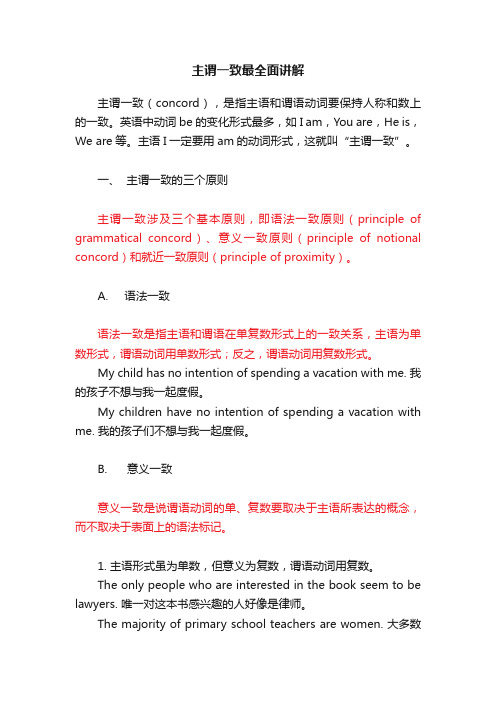
主谓一致最全面讲解主谓一致(concord),是指主语和谓语动词要保持人称和数上的一致。
英语中动词be的变化形式最多,如I am,You are,He is,We are等。
主语I一定要用am的动词形式,这就叫“主谓一致”。
一、主谓一致的三个原则主谓一致涉及三个基本原则,即语法一致原则(principle of grammatical concord)、意义一致原则(principle of notional concord)和就近一致原则(principle of proximity)。
A. 语法一致语法一致是指主语和谓语在单复数形式上的一致关系,主语为单数形式,谓语动词用单数形式;反之,谓语动词用复数形式。
My child has no intention of spending a vacation with me. 我的孩子不想与我一起度假。
My children have no intention of spending a vacation with me. 我的孩子们不想与我一起度假。
B. 意义一致意义一致是说谓语动词的单、复数要取决于主语所表达的概念,而不取决于表面上的语法标记。
1. 主语形式虽为单数,但意义为复数,谓语动词用复数。
The only people who are interested in the book seem to be lawyers. 唯一对这本书感兴趣的人好像是律师。
The majority of primary school teachers are women. 大多数小学老师都是女的。
2. 主语形式为复数,而意义上却是单数,谓语动词用单数。
Billiards is becoming more and more popular in some cities. 桌球在一些城市里越来越受欢迎。
C. 就近一致就近一致是指当主语由两个或两个以上名词或代词组成时,谓语动词的数要与它紧邻的名词或代词的数一致。
英语语法之主谓一致

主谓一致1.在一般现在时中,若主语是单数第三人称,谓语动词则要加-s或-es, 具体变化同名词的单数变复数。
如:He goes to school at 8 every morning. 不说:He go….1)单数第三人称作主语的词包括:单数人称代词:he, she, it不定代词:each, everyone人名:John, Bill Gates等。
普通单数名词:my brother, English等。
2)单数动词的变化有:be—is; have—has; 其他动词在词尾加-s或-es, 具体变化同名词的单数变复数,work—works, study--studies。
若主语是单数第一、第二人称或复数,则谓语动词永原形,不需要加-s或-es.常见的这样的主语有:单数人称代词:I, you 复数人称代词:we, you, they 复数名词:students, books等。
2.在助动词或情态动词后面,直接接动词原型。
a. She can sing in English.b. He goes to school early. / He doesn’t go to school early.3.There be 句型的主谓一致。
研究下列句子:There is a book on the desk. There are two books on the desk.There be 句型是一倒装结构,因此谓语动词的单复数要与be动词后面的名词一致。
4.“数量词+名词”结构的主谓一致在上述数量词中,有些还可以接of 短语连用。
具体用法如下:5.单数形式的名词作主语与谓语动词形式的关系一般来说,单数名词作主语,谓语动词用单数形式,这个符合英语中的语法上一致原则。
但此种情况也有例外。
现在详细归纳如下:1)Many a +名词单数,虽为复数概念,但谓语用单数。
a.There is many an error that he has neglected.b.Many a man and (many a) woman has wished that he or she had had abetter education. (Many men and women have….)2)More than one+可数名词单数,是复数概念,但谓语用单数。
英语语法主谓一致

主谓一致主谓一致Subject-Verb Concord即谓语动词在人称和数上要和主语保持一致;主谓一致包括语法一致、意义一致和就近一致;语法一致即谓语动词在单复数形式上要和主语保持一致;意义一致就是谓语动词要和主语意义上的单复数保持一致;就近一致就是谓语动词要和靠近它的主语部分保持一致..表里不一主谓一致中的"表里不一"现象1;"more than one +名词"作主语时;谓语动词常用单数.例如:More than one teacher gets the flowers. 不止一个教师得到了花. 2;"many a +名词"作主语时;从意义上看是复数;但谓语动词常用单数.例如:Many a student has been sent to plant trees. 很多学生被派去植树.3;"half of ;the rest of ;most of ;all of及百分数或分数+of 等后接名词"作主语时;谓语动词形式根据of后的名词而定.例如:Three fourths of the surface of the earth is covered with water.地球表面四分之三为水所覆盖.4;all指人时;动词用复数;all指物时;动词用单数.例如:"All are present and all is going well." 所有人全部到场了;一切进展顺利5;what引导的主语从句;谓语动词可视表语而定:表语是单数名词时;动词用单数;相反;则用复数.例如:What they want to get are a number of good books.他们想得到的是大量的好书.6;and连接的两个单数名词前若用each ;every ;no修饰;该名词短语作主语时;谓语动词用单数形式.例如:No book and no pen is found in the schoolbag.书包里没有书和钢笔.7;当主语后面有as well as ;with ;along with ;together with ;but ;like ;rather than ;except;逗号加and连接几个名词等引导的短语时;谓语动词要与最前面的主语保持一致.例如:My father as well as his workmates has been to Beijing. 我父亲和他的同事曾去过北京.8;each作主语的同位语时;谓语动词由主语来决定;与each无关.例如:They each have a bike. 他们每人有一辆自行车.9;动词不定式;动词-ing形式短语作主语时;谓语动词常用单数.例如:Going out for a walk after supper is a good habit.晚饭后出去散步是一个好习惯.10;the following作主语时;谓语动词的数与后面名词的数保持一致.例如:The following are good examples下面是一些好例子.11;以-ics结尾的学科名词;如politics ;physics ;mathematics等作主语时;谓语动词用单数.以-s结尾的名词news ;works ;plastics等同属此类.例如:Politics is now taught in all schools. 现在各学校都开设政治课.当以-ics结尾的学科名词表示"学科"以外的意义时;用作复数;如:mathematics运算能力politics政治观点economics经济意义等..12;有些用来表示由两个对应部分组成一体的名词复数trousers ;glasses ;shoes .shorts .scissors .scales等作主语时;前面若有"一条";"一副";"一把"之类的单位词;动词用单数;若没有单位词或单位词是复数;则谓语动词用复数.例如:The shoes are all right. 这些鞋子都很合适.还有一些以-s结尾的名词通常用复数:arms武器.clothes .contents .minutes记录.remains遗体.thanks等13;"one and a half +名词"作主语时;谓语动词要用单数.例如:One and a half apples is left on the table. 桌子上有一个半苹果.14;"One or two more +复数名词"作主语时;谓语动词用复数.例如:One or two persons are sent there to help them do the work. 要派一两个人到那儿去给他们帮忙.15;"one of+复数名词+ 定语从句"结构中;定语从句的谓语动词要用复数;而在"the only one of +复数名词+定语从句"的结构中;"the one of + 复数名词+定语从句"定语从句的谓语动词要用单数.例如:He is one of the students who get there on time.他是准时到达那里的学生之一.16;表示时间;距离;金钱等的复数名词作主语表达一个整体概念时;谓语动词常用单数;但若强调数量;谓语动词可用复数.例如:One million dollars is a lot of money. 一百万美元是一大笔钱. -s结尾一以-s结尾的疾病名称作主语的主谓一致问题;以-s结尾的疾病名称作主语的主谓一致问题;如:arthritis ;bronchitis ;diabetes ;mumps ;phlebitis ;rickets;这类以-s结尾的疾病名称作主语时;谓语动词通常用作单数..例如:Arthritis causes great pain in the joints of the patient.二以-s结尾的游戏名称作主语的主谓一致问题;以-s结尾的游戏名称作主语时;谓语动词通常用作单数..例如:Darts is basically an easy game.但当Darts;Marbles等的意义为游戏器具而非游戏名称时;谓语动词通常用作复数..例如:Three darts are thrown at each turn.All nine skittles were brought down by the good throw.三以-s结尾的地理名称作主语的主谓一致问题;某些以-s结尾的地理名称;如果是国名;如the United States;the Netherlands等;因其是单一政治实体;所以谓语动词用作单数..例如:The United States was hit by the Great Depression in 1930s'.In early January 1996 the Netherlands was hit by its worst storm since 1976.但如果是群岛、山脉、海峡、瀑布等地理名称作主语;谓语动词用作复数..例如:The West Indies are commonly divided into two parts.四以-ics结尾的学科名称作主语的主谓一致问题;某些以-ics结尾的学科名称作主语时;如physics ;mathematics ;mechanics ;optics ;acoustics ;politics;st atistics ;economics ;linguistics ;athletics等;谓语动词通常用作单数..例如:The third world economics is promising.Athletics is a required course for students of all grades.但如果这类名词表示学科以外的其它含义;可作复数用..例如:Athletics have been greatly encouraged at this college.五其它以-s结尾的名词的主谓一致问题;.以-s结尾的由两部分组成的物体名称作主语;英语中有一些通常以-s结尾的由两部分组成的物体名词;如glasses ;pincers ;pliers ;scissors ;shorts ;suspenders ;trousers 等; 为复数名词;后接复数谓语集合名词1单数—复数型.凡是有复数词尾变化形式的集合名词都属于此类.如:a class—classes; a family—families; a government—governments; anarmy—armies ;a people—peoples民族; a group—groups; a crowd—crowds; a crew—crews等.这类集合名词强调的是整体性;即当作一个整体或多个整体来看待.属于这类集合名词的单数作主语时;谓语动词用单数;复数形式作主语时;谓语动词用复数.例如A big crowd often gathers on the square every morning.每个上午一大群人经常聚集在广场上The government has decided to pass the bill.政府已决定通过这一法案There are huge crowds in the streets on Sunday.星期天有大群大群的人在街上..There are many English-speaking peoples in the world.在世界上有许多讲英语的民族..但应注意;这类集合名词的单数形式有时表示复数概念;所以这些集合名词的单数形式也可归为"单复同形型"中.2单数型.这类集合名词表示的是人或事物的整体;即把这类人或事物的全部包括在内;所以只有单数形式.如作主语;谓语动词常用单数.这类名词常见的有:humanity ;mankind ;proletariat等.例如The proletariat is the greatest class in the history of mankind. In the fields of production and scientific experiment ;mankind makes constant progress.3复数型.这类集合名词在形式和内容上是相互矛盾的;就是说它们只有单数形式;但表达的都是复数概念.它强调的是集体中的个体性.这类名词有:police ;cattle ;faculty ;flock ;machinery ;vermin ;personnel等.它们作主语时;谓语动词要用复数.例如The police have caught the murder.Our personnel are very highly trained.The vermin are very dangerous.4单复同形型.这类集合名词的单数形式既可表示单数也可表示复数.作主语时;用单数动词或复数动词均可;有时意义区别不大;具体看语境;是强调集体还是个体..例如The school teaching staff are is excellent.The public is are requested not to litter in the park.The teaching profession claims to be badly paid.这类集合名词常见的有:class;family;team;crew;board;herd;committee;party;jury;enemy;au dience等.根据说话人的心理意向若把这个集合名词所代表的人或事物看作一个整体;就认为是单数;用单数动词;若把它所代表的人或事物看作若干个个体的话;就认为其为复数;用复数动词.试比较:The football team is playing well.那个足球队打得非常漂亮. The football team are shavings bath and are then coming back here for tea. 足球队员们正在洗澡;然后来这里吃茶点.The family is a very happy one.那个家庭是一个非常幸福的家庭.That family are very pleased about the news of William's success. 全家人对威廉的成功都感到很高兴.典型例题1 并列结构作主语时谓语用复数Reading and writing are very important.注意:当主语由and连接时;如果它表示一个单一的概念;即指同一人或同一物时;谓语动词用is;and 此时连接的两个词前只有一个冠词;共用一个冠词用单数;表示The iron and steel industry is very important to our life.The League secretary and monitor ___ asked to make a speech at the meeting.A. isB. wasC. areD. were答案 B. 注:先从时态上考虑.这是过去发生的事情应用过去时;先排除A.;C..本题易误选D;因为The League secretary and monitor 好象是两个人;但仔细辨别;monitor 前没有the;在英语中;当一人兼数职时只在第一个职务前加定冠词.后面的职务用and 相连.这样本题主语为一个人;所以应选B.2 主谓一致中的就近原则当there be 句型的主语是一系列事物时;谓语应与最邻近的主语保持一致.There is a pen;a knife and several books on the desk..There are twenty boy-students and twenty-three girl-students in the class.总的来说;在由not only…but also…;not just…but…;or;either…or…;neither…nor…连接主语的句子中及在there be句型中;谓语动词的单复数按就近原则处理;即按与谓语动词最靠近的那个主语来确定谓语动词的单复数形式..如:Not only John but also I am going to Shanghai next week.Either you or she is to go.There is a pen ;a few envelops and some paper for you.3 谓语动词与前面的主语一致当主语后面跟有with ;together with ;like; except ;but ;no less than ;as well as 等词引起的短语时;谓语动词与前面的主语一致.The teacher together with some students is visiting the factory. He as well as I wants to go boating.4 谓语需用单数1 代词each和由every ;some ;no ;any等构成的复合代词作主语;或主语中含有each ;every;谓语需用单数.Each of us has a tape-recorder.There is something wrong with my watch.2 当主语是一本书或一条格言时;谓语动词常用单数.The Arabian Night is a book known to lovers of English.<一千零一夜>是英语爱好者熟悉的一本好书.3 表示金钱;时间.距离.价格或度量衡的复合名词作主语时;通常把这些名词看作一个整体;谓语一般用单数.用复数也可;意思不变.Three weeks was allowed for making the necessary preparations. Ten yuan is enough.5 指代意义决定谓语的单复数1 在代词what ;which ;who ;none ;some ;any ;more ;most ;all等词的单复数由其指代的词的单复数决定.All is right. 一切顺利.All are present. 所有人都到齐了.2 集体名词作主语时;谓语的数要根据主语的意思来决定.如family ;team;group;club ;public ;audience ;crew ;crowd ;class ; company ;committee等词后用复数形式时;意为这个集体中的各个成员;用单数时表示该个集体.His family isn't very large. 他家不是一个大家庭.His family are music lovers. 他的家人都是音乐爱好者.但集合名词people ;police ;cattle ;poultry家禽.militia民兵.vermin 害虫等在任何情况下都用复数形式.Are there any police around3有些名词;如variety ;number ;population ;proportion ;majority 等有时看作单数;有时看作复数.A number of +名词复数+动词的第三人称单数形式.The number of +名词复数+动词非第三人称单数形式.A number of books have lent out.The majority of the students like English.6 与后接名词或代词保持一致1 用half of; part of ;most of ;a portion of 等词引起主语时;动词通常与of后面的名词;代词保持一致.Most of his money is spent on books.Most of the students are taking an active part in sports.2 在一些短语;如 many a 或 more than one 所修饰的词作主语时;谓语动词多用单数形式.但由more than… of 作主语时;动词应与其后的名词或代词保持一致.Many a person has read the novel. 许多人都读过这本书.More than 60 percent of the students are from the city.百分之六十多的学生都来自这个城市.7 the+形容词/国籍形容词..表示一类人/一国人;作主语;谓语动词用复数..8 the+姓氏的复数;表示一家人或两夫妇;作主语时;谓语动词用复数;9四则运算时;谓语动词用单数..10 表示;时间;距离;重量;金额;书名的复数名词作主语时;通常当做整体看待;谓语动词用单数..。
英语专业四级语法之主谓一致

动名词短语、不定式短语、名词性从句作主语,谓语用单数。女口:
To un dersta nd the situati on completely requires more thought tha n has bee n give n thus far.要全面地了解局势,需要比现在更深入的思考。
当用half of, part of, most of, a portion of等词构成的主语时,动词通常与of后面的名词、代词保持一致。女口:
同样,在某些成语里,由and连接的两个成分指同一件事,同一个概 念,这时谓语也常用单数。
Early to bed and early to rise makes a man healthy, wealthy and wise.早起早睡使人健康,富有和智慧。
Trial and error is the source of our kno wledge.
Neither of us has gone through regular training.
我们两人都没受过正规训练。
(2)由限定词either,neither,each, every等修饰名词时,用单数形式。
英语语法之 主谓一致

Thirty dollars __i_s _ too high a price for the book.(be) Fifteen miles _s_ee_m__s like a long walk to me. (seem)
(3)不定式、动名词、名词性从句作主语,谓语 动词一般用单数。
02 意义一致
(1)形式为单数但意义为复数概念的 police, cattle,people 等作主语时,谓语动词用复数。 Cattle eat grass. 牛吃草。 The police were called in. 警察被召来了。 ( 2 ) “the+ 一 类 人 ” 的 the young/poor/rich/ dead/injured等,“the+姓氏复数”作主语,谓语 动词用复数。 The Greens are going to Paris. 格林一家要去巴黎。 The injured were sent to the hospital. 伤员被送往医院。
(9)What引导的主语从句作主语时,谓语动 词的单复数取决于作表语的名词的单复数。
1.What surprised me most __i_s___(be)his attitude towards his study. 2.What his farther left her__a_r_e__(be) only some books.
Listening to music makes me relaxed after a busy day.听音乐使我在一天的忙碌之后得到了放松。 To help her __i_s__(be) not to do everything for her. When he is coming _s_e_e_m_s_ (seem) very important.
什么是英语中的主谓一致
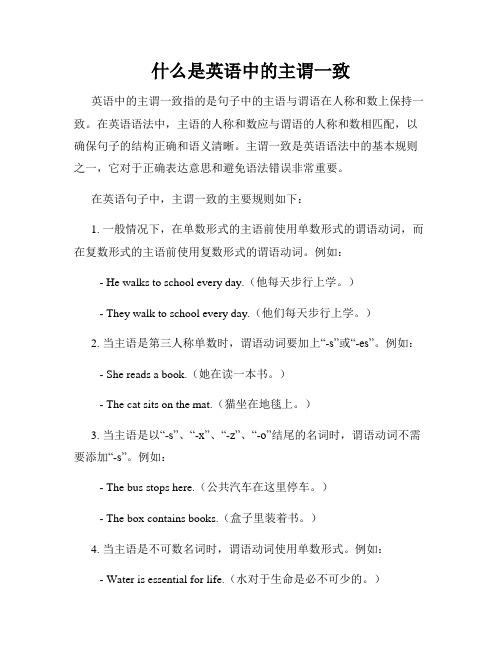
什么是英语中的主谓一致英语中的主谓一致指的是句子中的主语与谓语在人称和数上保持一致。
在英语语法中,主语的人称和数应与谓语的人称和数相匹配,以确保句子的结构正确和语义清晰。
主谓一致是英语语法中的基本规则之一,它对于正确表达意思和避免语法错误非常重要。
在英语句子中,主谓一致的主要规则如下:1. 一般情况下,在单数形式的主语前使用单数形式的谓语动词,而在复数形式的主语前使用复数形式的谓语动词。
例如:- He walks to school every day.(他每天步行上学。
)- They walk to school every day.(他们每天步行上学。
)2. 当主语是第三人称单数时,谓语动词要加上“-s”或“-es”。
例如:- She reads a book.(她在读一本书。
)- The cat sits on the mat.(猫坐在地毯上。
)3. 当主语是以“-s”、“-x”、“-z”、“-o”结尾的名词时,谓语动词不需要添加“-s”。
例如:- The bus stops here.(公共汽车在这里停车。
)- The box contains books.(盒子里装着书。
)4. 当主语是不可数名词时,谓语动词使用单数形式。
例如:- Water is essential for life.(水对于生命是必不可少的。
)- Music brings joy to people.(音乐给人们带来快乐。
)5. 当主语是复合主语,且由and连接时,谓语动词使用复数形式。
例如:- Tom and Jerry are good friends.(汤姆和杰瑞是好朋友。
)6. 当主语是复合主语,且由or、nor连接时,谓语动词与最接近的主语保持一致。
例如:- Either John or his brothers are responsible for the mess.(要么是约翰,要么是他的兄弟们对这个乱糟糟的地方负责。
英语语法总结主谓一致

英语语法总结主谓一致英语语法总结主谓一致总结就是对一个时期的学习、工作或其完成情况进行一次全面系统的回顾和分析的书面材料,它可以有效锻炼我们的语言组织能力,让我们一起来学习写总结吧。
那么总结要注意有什么内容呢?下面是店铺整理的英语语法总结主谓一致,仅供参考,欢迎大家阅读。
英语语法总结主谓一致11.主语是he ,she, it, either, neither, each, anything, something, everything, nothing, someone, everyone, anyone, nobody, no one, 等代词时,谓语动词用单数。
Someone is asking for you. 有人在找你。
Everyone is here. 大家都来了。
Each of the boys has an apple.2. 表示总称意义的名词people, cattle, police做主语时,谓语动词用复数。
Cattle are farmer’s friends.The policeman is standing at the street corner. The police are searching for him.3. 主语是:时间,距离,价格等名词,即使是复数形式,谓语动词只用单数。
Three years passes quickly.Two meters is not long enough.4.主语是:clothes, glasses, trousers, shoes, socks, gloves 等名词时,谓语动词用复数。
The trousers are not expensive.Your socks are over there.5.主语是:family, class, team, group等名词时,如果是作为整体,谓语动词用单数;如果作为其中一个个的成员,谓语动词用复数。
初中英语语法主谓一致
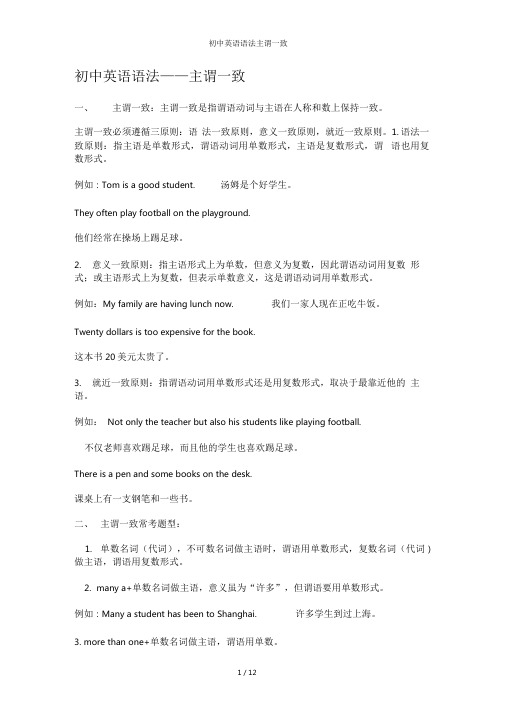
初中英语语法——主谓一致一、主谓一致:主谓一致是指谓语动词与主语在人称和数上保持一致。
主谓一致必须遵循三原则:语法一致原则,意义一致原则,就近一致原则。
1. 语法一致原则:指主语是单数形式,谓语动词用单数形式,主语是复数形式,谓语也用复数形式。
例如:Tom is a good student. 汤姆是个好学生。
They often play football on the playground.他们经常在操场上踢足球。
2.意义一致原则:指主语形式上为单数,但意义为复数,因此谓语动词用复数形式;或主语形式上为复数,但表示单数意义,这是谓语动词用单数形式。
例如:My family are having lunch now. 我们一家人现在正吃牛饭。
Twenty dollars is too expensive for the book.这本书20美元太贵了。
3.就近一致原则:指谓语动词用单数形式还是用复数形式,取决于最靠近他的主语。
例如:Not only the teacher but also his students like playing football.不仅老师喜欢踢足球,而且他的学生也喜欢踢足球。
There is a pen and some books on the desk.课桌上有一支钢笔和一些书。
二、主谓一致常考题型:1.单数名词(代词),不可数名词做主语时,谓语用单数形式,复数名词(代词)做主语,谓语用复数形式。
2.many a+单数名词做主语,意义虽为“许多”,但谓语要用单数形式。
例如:Many a student has been to Shanghai. 许多学生到过上海。
3. more than one+单数名词做主语,谓语用单数。
例如: More than one student has ever been to Beijing.不止一个学生曾经去过北京。
4.表示时间,价格,重量,数目,长度,数学运算等的词或短语做主语时,这些通常作一个整体概念,谓语用单数形式。
英语语法之主谓一致总结
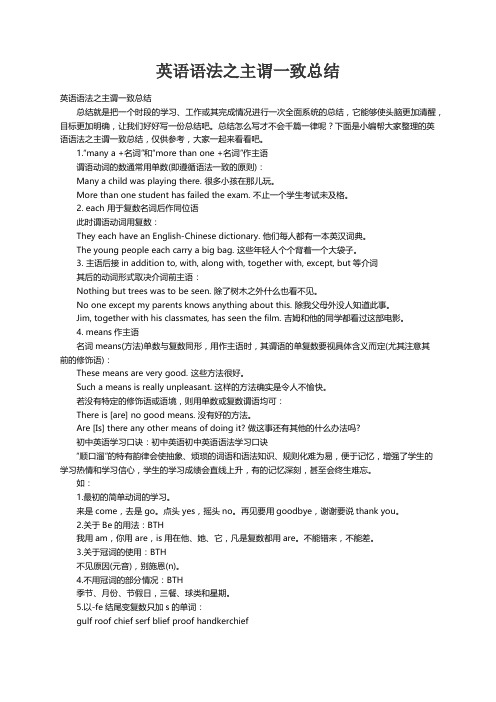
英语语法之主谓一致总结英语语法之主谓一致总结总结就是把一个时段的学习、工作或其完成情况进行一次全面系统的总结,它能够使头脑更加清醒,目标更加明确,让我们好好写一份总结吧。
总结怎么写才不会千篇一律呢?下面是小编帮大家整理的英语语法之主谓一致总结,仅供参考,大家一起来看看吧。
1.“many a +名词”和“more than one +名词”作主语谓语动词的数通常用单数(即遵循语法一致的原则):Many a child was playing there. 很多小孩在那儿玩。
More than one student has failed the exam. 不止一个学生考试未及格。
2. each 用于复数名词后作同位语此时谓语动词用复数:They each have an English-Chinese dictionary. 他们每人都有一本英汉词典。
The young people each carry a big bag. 这些年轻人个个背着一个大袋子。
3. 主语后接in addition to, with, along with, together with, except, but等介词其后的动词形式取决介词前主语:Nothing but trees was to be seen. 除了树木之外什么也看不见。
No one except my parents knows anything about this. 除我父母外没人知道此事。
Jim, together with his classmates, has seen the film. 吉姆和他的同学都看过这部电影。
4. means作主语名词means(方法)单数与复数同形,用作主语时,其谓语的单复数要视具体含义而定(尤其注意其前的修饰语):These means are very good. 这些方法很好。
Such a means is really unpleasant. 这样的方法确实是令人不愉快。
- 1、下载文档前请自行甄别文档内容的完整性,平台不提供额外的编辑、内容补充、找答案等附加服务。
- 2、"仅部分预览"的文档,不可在线预览部分如存在完整性等问题,可反馈申请退款(可完整预览的文档不适用该条件!)。
- 3、如文档侵犯您的权益,请联系客服反馈,我们会尽快为您处理(人工客服工作时间:9:00-18:30)。
主谓一致
主谓一致是指:1)语法形式上要一致,即单复数形式与谓语要一致;2)意义上要一致,即主语意义上的单复数要与谓语的单复数形式一致;3)就近原则,即谓语动词的单复形式取决于最靠近它的词语。
一般来说,不可数名词用动词单数,可数名词复数用动词复数,但当不可数名词前有表示数量的复数名词时,谓语动词用复数形式。
一、并列结构作主语时的主谓一致
并列结构作主语时谓语用复数,但是当主语由and连结时,如果它表示一个单一的概念,即指同一人或同一物时,谓语动词用单数,and 此时连接的两个词前只有一个冠词。
同时,如果and连接的两个单数名词前若用each,every,no修饰,该名词短语作主语时,谓语动词也要用单数形式。
e.g. I) To mean to do something and to actually do something are two separate things.
想干一件事和真干一件事是两回事。
II) The food and the textile industry depend mainly on agriculture for raw material.
粮食工业和纺织工业主要靠农业提供原料。
III) The iron and steel industry is very important to our national economy.
钢铁工业在国民经济中起重要作用。
IV) No book and on pencils found in the schoolbag.
书包里没有书和钢笔。
二、主谓一致中的就近原则
1.当there be句型的主语是一系列事物时,谓语应与最邻近的主语保持一致。
e.g. I) There is a teacher and some students in the classroom.
教室里有一名老师和一些学生。
II) There are four books and a pencil box in his bag.
在他的包里有四本书和一个铅笔盒。
2.当either… or… 与neither… nor,连接两个主语时,谓语动词与最邻近的主语保持一致。
如果句子是由here, there引导,而主语又不止一个时,谓语通常也和最邻近的主语一致。
e.g. I) Either he or his children are to take part in the party.
不是他就是他的孩子们来参加这个晚会。
II) Neither my wife nor I am to persuade my daughter to change her mind.
我和我爱人都没法说服我的女儿改变主意。
III) Here is a pen, a few envelops and some paper for you.
这儿有一支笔,几个信封和一些纸给你。
三、谓语动词与主语的一致
在主语是单数的情况下,如果主语后面跟有with,together with,like,except,but,no less than,as well as 等词引起的短语时,谓语动词与前面的主语一致,即谓语动词仍用单数。
e.g. I) An expert, together with some assistants, was sent to help in this work.
一位专家和几位助手被派去协助这项工作。
II) Justice, as well as the law, demands that these criminals be severely punished.
法律和正义都要求严惩这些犯罪分子。
III) No one except his two daughters is interested in the program.
除了他的两个女儿之外没有人对这个节目感兴趣。
四、在下列情形下谓语需要用单数
1.代词each和由every,some,no,any等构成的复合代词作主语,或主语中含有each,every时,谓语需用单数。
e.g. I) Each of us has something to say.
II) Any of these books is helpful in your English study.
2.当主语是一本书或一条格言时,谓语动词常用单数。
e.g. Little Women is a book known to lovers of English.
3.表示金钱,时间,价格或度量衡的复合名词作主语时,通常把这些名词看作一个整体,谓语一般用单数(用复数也可,意思不变。
)。
e.g. I) Two days was allowed for making the necessary preparations.
II) Ten million dollars is not a small amount.
五、由指代意义决定的谓语单复数
1.代词what,which,who,none,some,more,most,all等词的单复数由其指代的词的单复数决定。
e.g. I) Which is your book?
Which are your books?
II) None of the books are easy enough for us.
None of this worries me.
2.集体名词作主语时,谓语的数要根据主语的意思来决定。
如family, audience, crew, crowd, class, company, committee等词后用复数形式时,意为这个集体中的各个成员,用单数时表示该个集体。
e.g. I) The committee meets twice a month. 委员会一月开两次会。
The committee are divided in opinion. 委员们意见有分歧。
II) The audience was enormous. 观众人很多。
The audience were greatly moved at the words. 听了这话听众都很感动。
3.有些名词,如variety,number,population,proportion 等有时看作单数,有时看作复数。
e.g. I) What is the population of Europe? 欧洲人口有多少?
One third of the population here are workers. 这里三分之一的人口是工人。
II) A number of students have passed the exam. 很多学生通过这次考试。
The number of students in this college has increased a lot.
这个学院的学生人数大大增加了。
六、与后接名词或代词的一致
1. 用half of, part of, most of, a portion of 等词引起主语时,动词通常与of后面的名词,代词保持一致。
e.g. Most of his money is spent on his daily necessities.
Most of the students have passed the exam.
2.在一些短语,如many a 或more than one 所修饰的词作主语时,谓语动词多用单
数形式。
e.g. I) Many a person has ever seen this movie.
II) More than one person has had that kind of experience.。
